Going to see the seals at Horsey Beach in Norfolk is certainly not your typical reason to head to the coast. This beach visit does not come with colourful beach huts and sun loungers.
Instead, picture yourself with a front row seat to an incredible wildlife spectacle where the action unfolds on a sandy stage on the Norfolk coast.
I got a whiff of the seal intrigue and decided to throw on my boots and head out in hot pursuit of these semi-aquatic wonders.
The reward for following my curiosity along the east coast of England would be a fascinating – and slightly bizarre – experience with the Horsey seals.
Introduction to Atlantic Grey Seals
My day of exploration started off on a cold December morning. I had a date with Atlantic grey seals in Norfolk. Or, shall we use its more elegant Latin name: Halichoerus grypus. The translation should give you an instant funny visual of the afternoon’s hosts – it means hook-nosed sea pig.
Imagination aside, I hadn’t the faintest idea what to expect. Which made this afternoon of UK wildlife discovery a highly anticipated event.
My curiosity was genuinely piqued. Sure, I’d seen seals in print, in the likes of NatGeo. But what would it be like to be up close and personal with these little guys?
Safety Tip: Maintain your distance
The first thing to point out is: the assumptions in my question are wildly flawed.
Intentionally getting up close and personal with seals is ill-advised. Seals do not fall in the ‘cute and cuddly’ category. Seals are wild animals. The type that come with strong jaws, sharp teeth, robust claws…you get the gist. You’d be potentially courting a nasty bite if you get too close.
And pups aside, grey seals are certainly not little guys. The males grow between 2 to 3 meters long. Imagine that!
But more on this later. Let’s start from the beginning.
Where can you find seals in the UK?
Admit it, isn’t there a little surge of pleasure that one gets from sharing a local travel tip with none other than a local? I certainly felt that little flush of pride when my suggestion of an excursion to see the Horsey grey seals was met with wide-eyed surprise by a few British friends (obviously not from the coast).
“We have seals here in England?”
“I know there are seals in Scotland but I never knew you could see seals in England.”
That did it. We were going on a coastal discovery tour.
The coasts of the Northern Atlantic Ocean are home to the grey seal. In the hunt for the best places to see seals in England, the research pointed to us to Cornwall, Norfolk, Lincolnshire, or Northumberland.
Looking into the Norfolk option further, we learnt that the county is booming with the Halichoerus grypus species – and increasingly so each year. It even boasts the UK’s largest seal colony at the site, Blakeney Point, a National Trust nature reserve.
I opted to check out the seals in Horsey Gap, Norfolk as that beach area is easy to access and roam on foot (vs. the boating option offered on Blakeney seal trips).
What is the best time to see the seals at Horsey Beach?
While seals can be spotted throughout the year in the UK, the best times to see seals and their seal pups tends to be:
August/September: South West England (Cornwall)
September/October: Wales (Pembrokeshire)
October/November: North of Scotland
November/December/January: East of England (Norfolk, Lincolnshire, Northumberland)
Norfolk’s Horsey Gap is a prime spot to view the large colony of Atlantic grey seals from the time the seal mums start arriving to haul out on the beach in late October until breeding season concludes in January.
This period is the birthing, mating, and breeding season for the Horsey seal colony.
Our December timing meant we’d catch major events on the busy grey seal calendar: it would be prime time to observe seal pups in their early stages of acclimating to life. Plus, by mid-December, a new season of courting for the seal mums would be well underway.
In other words, there would be plenty to observe.
Where to park at Horsey Beach
We arrived by car, and easily located the car park at Horsey Beach. (Note that the Horsey Gap Beach Car Park is not a National Trust car park. There is a National Trust car park located a few miles away at the Horsey Windpump).
After paying a minimal parking charge for a two hour stay, we set off in the direction of the sand dunes.
Signage at this site is abundant so following directions to the closest viewing point was a simple task. The walk from the car park to the first viewing point is about 3 minutes.
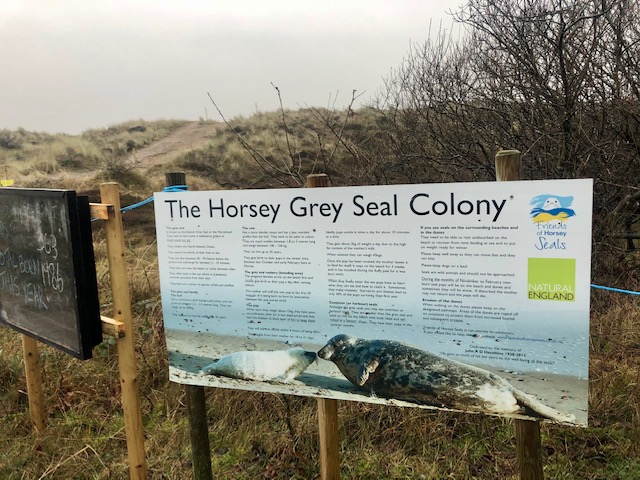
What it’s like to see Horsey seals for the first time
Strong winds accompanied us as we made our way to the marked viewing area along the sand dunes. The beach is always cordoned off during the breeding season.
The path became a small incline and I could feel my excitement mounting. So close to the beachfront, where a new landscape would emerge.
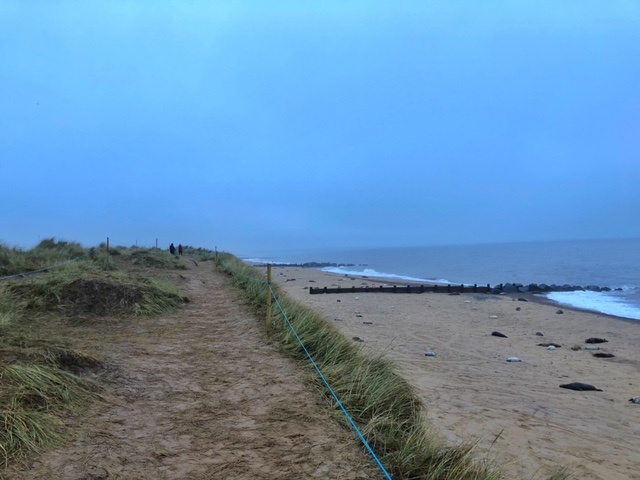
In the blink of an eye, the ratio of humans to mammals shifted – in massive favour to mammals. As Aladdin might say, before us lay a whole new world.
Dotted across the beach were lumps of still, grey forms of varying sizes. It’s a peculiar sight. Had I not known ahead of time what I’d find here, it wouldn’t have initially registered that these objects were seals lining the shores of Horsey Beach.

What happened next made me clasp my hands and squeal in pure childish glee…
A couple of the still forms jerked to life and began to move hurriedly across the sand.
Their belly dance like movement reminded me of the slinky toys of our childhood. Remember good ‘ol Slinky tumbling down the stairs?
How do seals at Horsey behave in breeding season?
Expect entanglements. Lots of ‘em. Over the 30-45 minutes that we spent watching the Horsey seals, there was a non-stop flurry of activity among a few female seals (cows) and several feisty male seals (bulls). December is prime mating season.
A Friends of Horsey beach warden explained that this breed of seal is polygynous and bulls will attempt to mate with up to 10 females during the season.
A fun fact I also learnt is that seals clapping their flippers is a type of mating call. Unfortunately, I did not observe any enchanting flipper movements but that didn’t mean an absence of (un)romantic interludes.
The most common sight to see on Horsey Beach that day were sudden bouts of sparring as competing bulls fiercely lobbied for the ladies’ attentions.
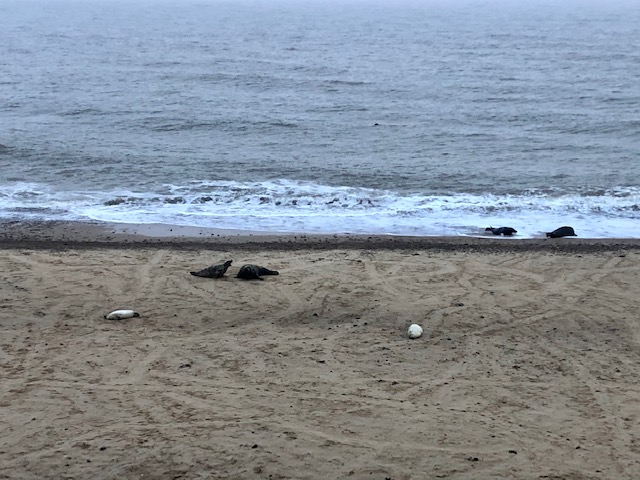
Most of these bull seals could be seen at the edge of the shore. A strategic position from where they could pounce whenever a cow went on the move.
Their territorial nature was on full display, leaving little wonder as to why maintaining distance was emphasized so much in visitor signage. Seals can be aggressive creatures.
“Is that frolic or fight?” we kept wondering.
Setting the drama of the adults aside, the other extraordinary sight to behold were the seal pups on Horsey.
Seeing seal pups at Horsey Beach
Countless furry white blobs were scattered across the beach, but further inland – likely an attempt to safely distance themselves from the combative bull seals.
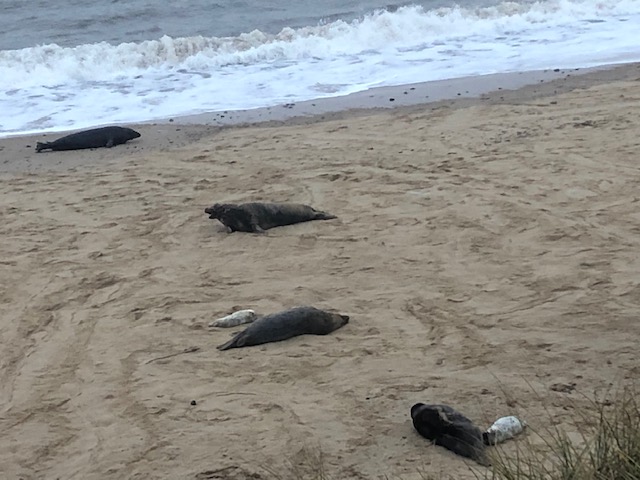
They looked so small and helpless!
Nonetheless, I dared not approach. While seal pups are still building their strength in those first few weeks, they are certainly still developed enough to bite ferociously. I’ve read about a few unfortunate incidents in local media.
Infected seal bites even have a name: ‘seal fingers’, and in a worst case scenario can lead to amputation!
We opted to pass on this possibility and maintained safe distance behind the ropes. Neither painful wounds, nor infections, nor limb removals were on our holiday vision boards.
Intriguing facts about seal pups at Horsey Beach
1. Their birth typically takes place a day after the seal mum arrives on the beach.
2. They spend their first three weeks drinking the seal mum’s milk which is incredibly rich in fat and builds their strength.
3. After 3 weeks they are weaned and seal mum shifts her attention to managing mating prospects.
4. Seal pups stick around on land for a couple more weeks and moult. This is where they shed their white fur for a thick grey waterproof coat.
A curious exception to this was observed in the 2020/2021 pupping season. Black seal pups were spotted on Horsey Beach – a rarity!
5. It’s tough love once mum is gone. Seal pups must now fend for themselves and learn the ropes of how to swim and forage for food on their own.
Sadly, lifeless pups may be observed among the bodies of seals on the beach. They die due to reasons such as starvation, disease, abandonment. Typically, their bodies remain on the beach until they are washed away.
Friends of Horsey Seals volunteers
The Friends of Horsey Seals are an awesome group of volunteer wardens who are typically on the beach daily, monitoring the seals and their environment.
Speaking with a Friends of Horsey Seals volunteer during a visit is a must – I cannot recommend it enough.
One such local warden was stationed along the sandy path dedicated to viewing the Horsey seals. Chatting with this guy was like wading through an ocean of knowledge. He shared key bits of knowledge on the animals, and even entertained us with a few seal antidotes.
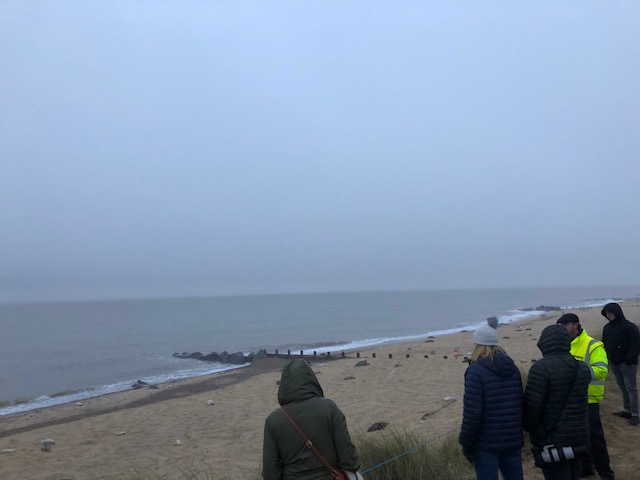
Why you should plan a visit to Horsey Gap to see seals
Top UK Winter Wildlife Activity: whether you are an avid wildlife enthusiast or a novice observer, seal-watching is rated as a top winter wildlife activity in the UK. It is well-worth the visit – even outside of the winter months!
Nostalgia: Visiting the seals at Horsey Beach is reminiscent of going on a field trip. Think back to some of your school trips – a few museum excursions perhaps? Well here we have a breezy coastal walk and sea creatures in their natural open environment. Is that a “Yes, sign me up!”
Unique UK Outing: ‘Best Things to Do in the UK’ lists typically primarily tout activities centred around castles, pubs, and tea houses. While those are wonderful choices, why not expand your appetite beyond the pursuit of the best scones and ‘cuppas’. Also discover the wonder and odd charm of the Atlantic grey seal.
Free Winter Activity: Here is an interesting outing that won’t break the bank. Seeing the Horsey seal colony is free! As is your access to excellent ‘in-house’ informational resources i.e. the Friends of Horsey Seals volunteers.
Bonus Activities in Norfolk: The area surrounding Horsey Gap is excellent for hiking and cycling so do take advantage. Exploring its spectacular landscape is one of the best things to do in Norfolk.
Why not combine seal-watching with cycling the Norfolk Broads?
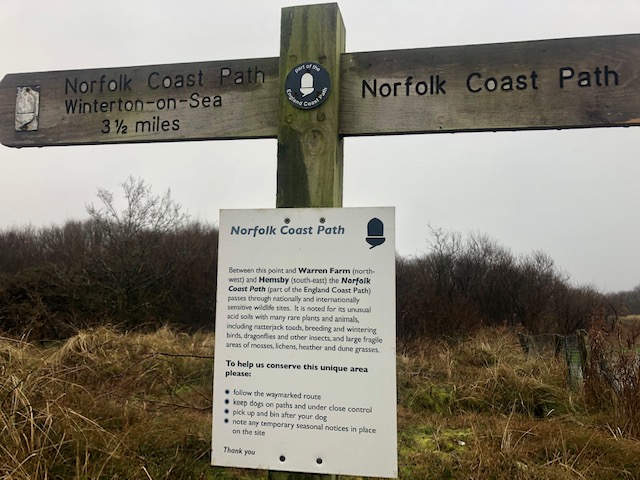
If a gentle hike is preferred, starting from the nearby Horsey Windpump (which is a lovely UK visitor attraction in its own right), you can walk a couple miles on a footpath which leads you to the viewing platform for seal-watching on Horsey Beach. You can then continue along the beautiful Norfolk Coast Path.
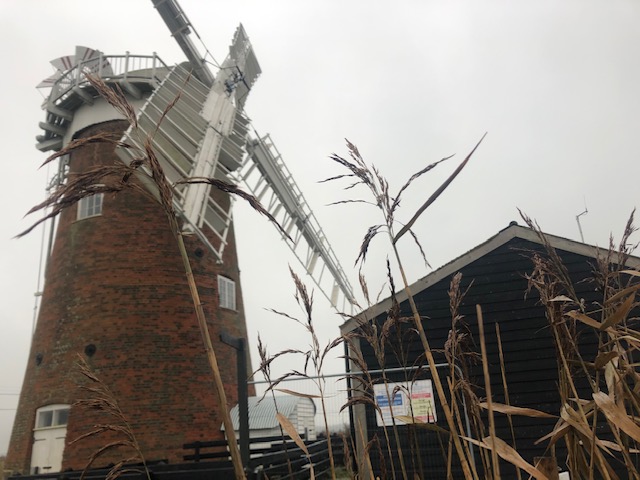
If you want to top up on wildlife spectacles, Norfolk has several more attractions. Park at Horsey Windpump and take a guided wildlife boat trip on Horsey Mere.
Or, there’s also the nearby Blakeney Point Nature Reserve which is a top-rated UK attraction for seeing wildlife. In addition to grey seals, it is a good site for observing migratory birds in the winter.
Final thoughts: was going to Horsey Beach to see seals worth it?
After an unforgettable experience on Horsey Beach, I can’t recommend this hassle-free wildlife excursion enough.
For those seeking a unique and interesting winter activity in England, seeing grey seals in Norfolk is a top choice for next season. You’ll be glad you made the trip here, and quite possibly leave with the urge to learn more about these fascinating mammals.
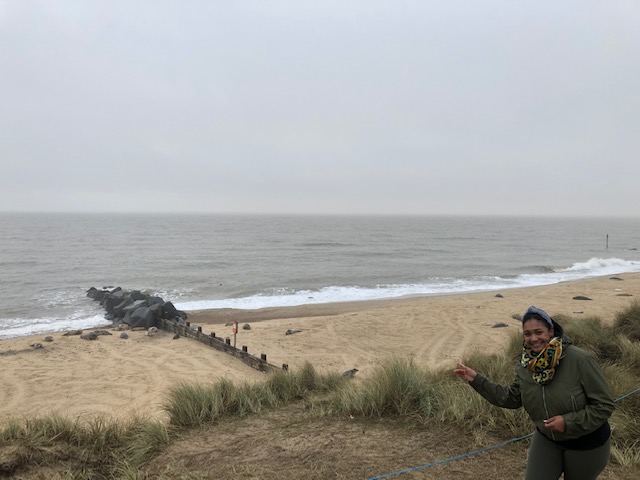
Discover more from Simone Says GO!
Subscribe to get the latest posts sent to your email.
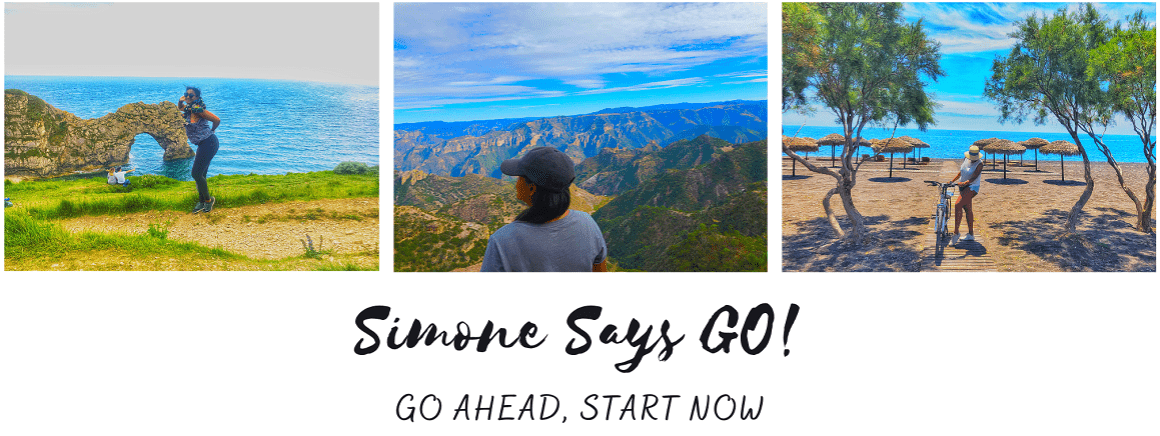
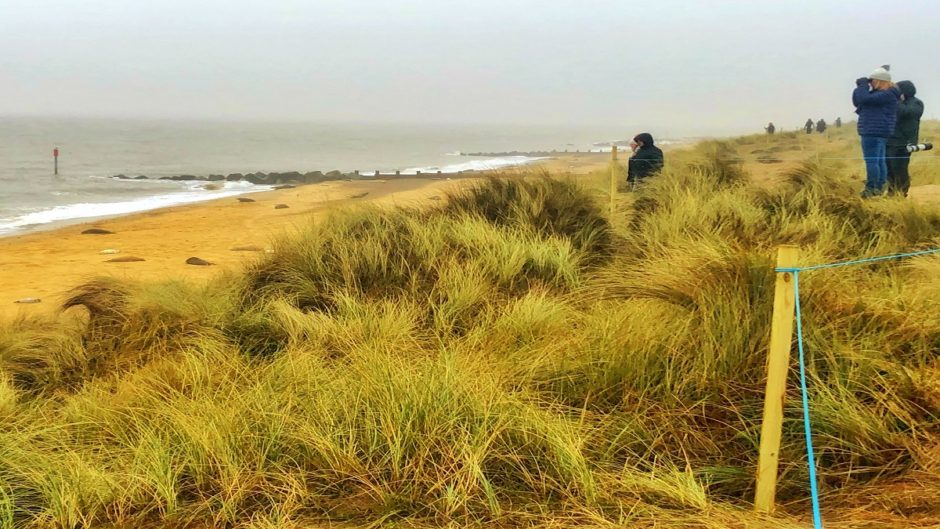
I would love to go and see the seals. What an experience! Thanks for sharing. ?
Thanks for reading, Rachel. They make for such an interesting day out – I hope you make it out there next winter!
That was an excellent read. The Norfolk coast has been on my to visit list for a while, but the rest of the family aren’t as keen. I’ll be letting them know about the seals. Roll on next Winter!
Thanks for sharing.
Thank you, Graham! Surely their interest will perk up once you throw seals into the mix. I bet that’ll do the trick. I’m also hoping to return next winter, perhaps will rent a kayak and see more of the Norfolk Broads. Fingers-crossed!
I thought seals are only found in the Artics! Wow, which means it is possible for me to go seal sighting in UK. Of course, setting aside for the next season! Thanks, Simone for this article. I also imagined myself during our visit to the zoo last year, I did squeal a bit seeing amazing creatures. 😉
Thanks, Vinn! They truly are a fun discovery in the UK – many folks don’t know about them it seems.
Whether it’s Horsey or another one of the seal-watching sights (Cornwall would be quite nice too – very scenic), hopefully you get to check them out. Only another great reason to get out to the coast!
Oooh! It is great when you can see seals in person. I live near a ton of beaches and still haven’t seen them myself before. Seeing all of those gray seals is so cool! They’re just chilling, hopefully. Pretty cool to learn about these seal pup facts. The mom seals really move on quickly. Thanks for sharing your adventure!
Nancy ✨ mdrnminimalists.com
Thanks, Nancy! Just reading up now on the different types of seals in California. You definitely have them ‘in your backyard’ – you might just happen upon one of their “haul out” sites on the Pacific coast one of these days.
I didn’t know we had seals in England. I really need to start planning some travel in my home country because it is embarrassing that I didn’t know that! I love reading posts about the UK, hopefully will convince me to come home and travel for a while so I can see my friends and family more!
Jamie
Don’t you worry you’re certainly not the only one! I constantly tease my guy that because of me he’s learning & seeing so much of his home country now, lol.
Pretty sure we’re going to have to do way better than seals though to get you to buy that ticket out of New Zealand!